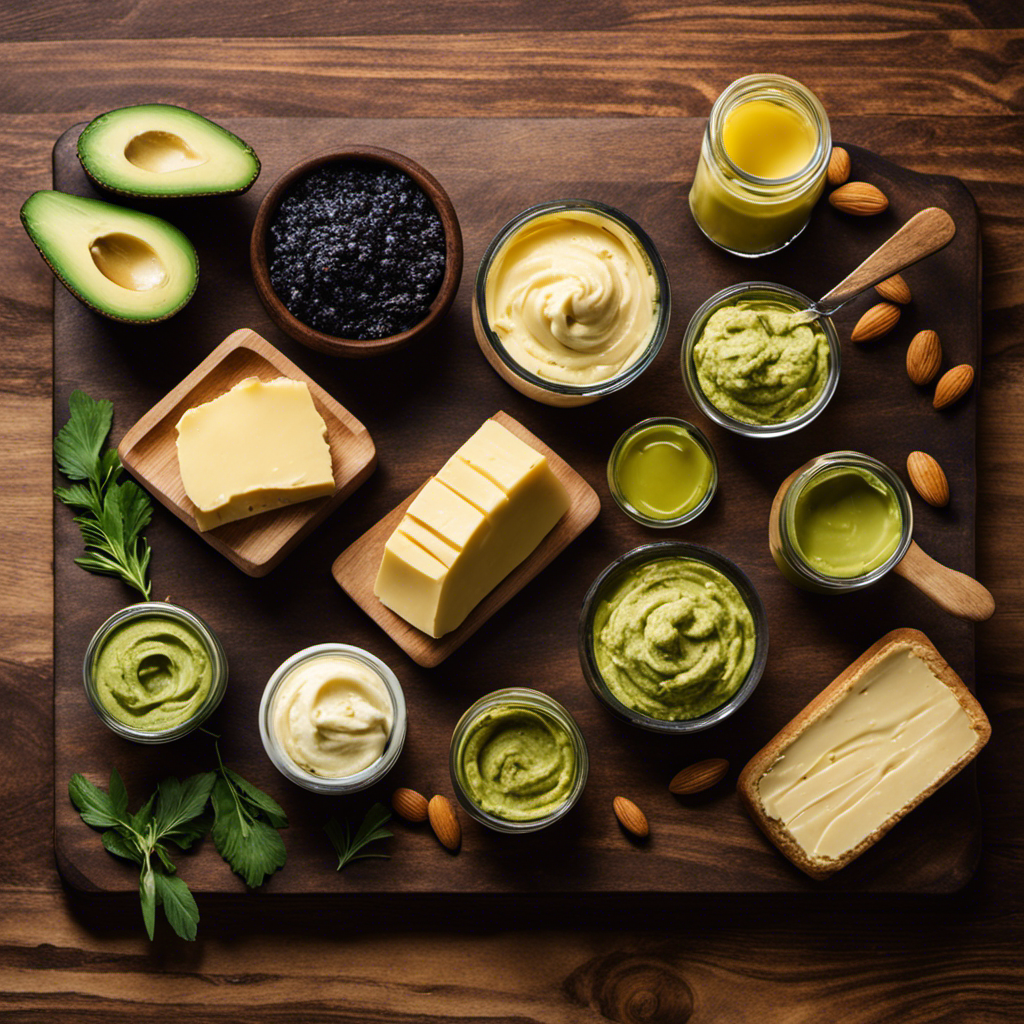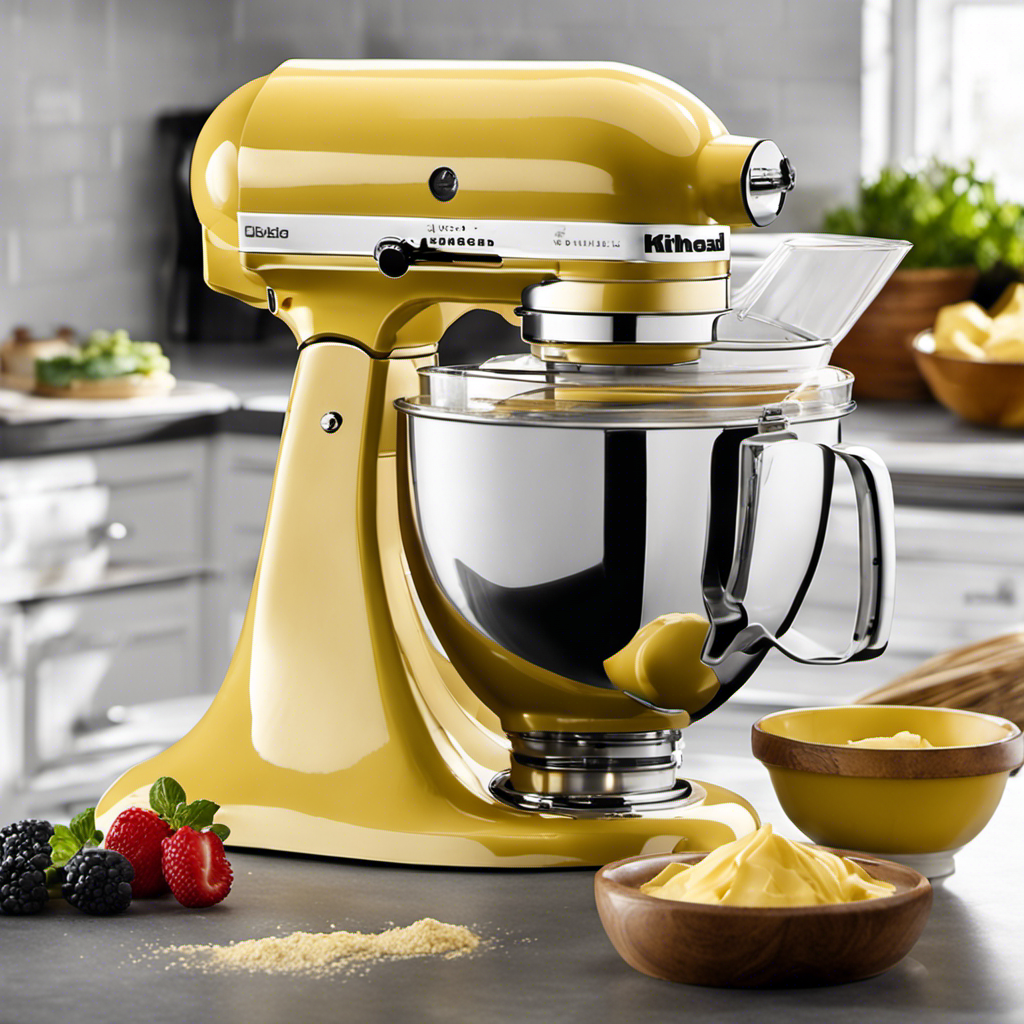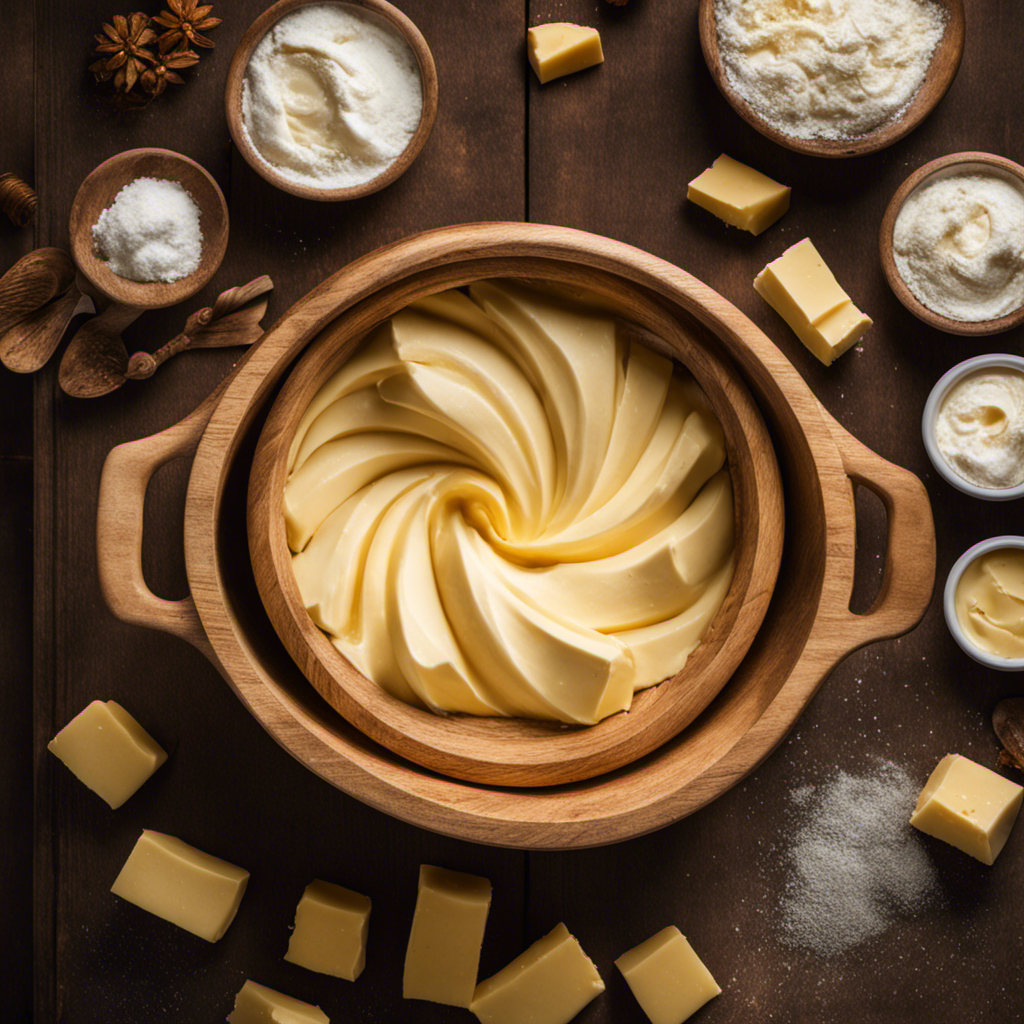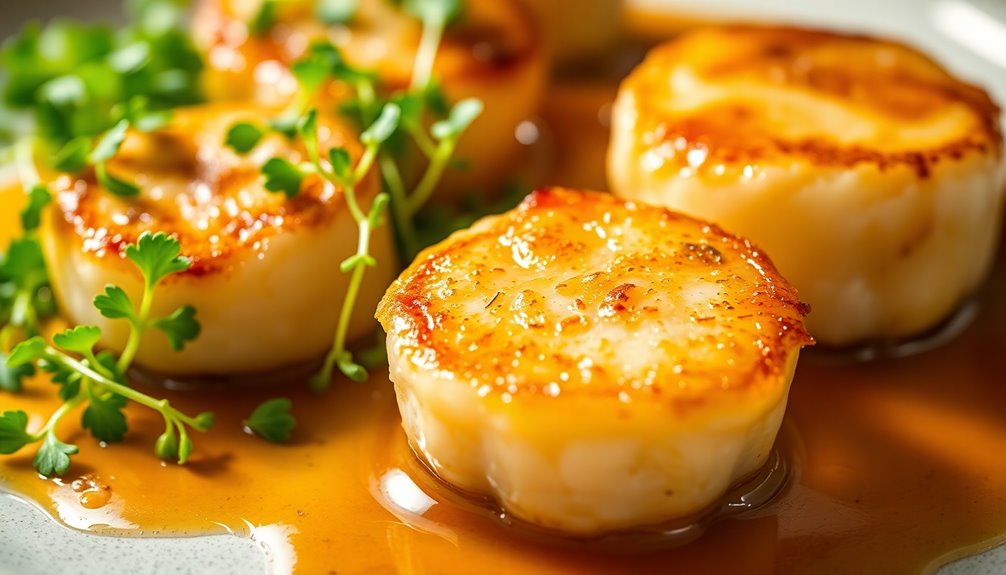Managing diabetes can be difficult when it comes to finding the right foods to regulate blood sugar levels. This dilemma is particularly evident when it comes to choosing the appropriate type of butter.
But fear not! In this article, we’ll dive into the world of butter and explore which types are best for diabetes. By evaluating the impact on blood sugar levels, comparing nutritional content, and understanding how it affects insulin resistance, we’ll uncover the butter options that can help you manage your diabetes effectively.
So let’s spread the knowledge and find the perfect butter for your diabetic diet!
Key Takeaways
- Butter alternatives such as margarine or vegetable spreads may have a lower glycemic index compared to traditional butter, making them a better option for diabetes management.
- Butter made from grass-fed cows or organic sources may have a lower glycemic index and be a healthier choice for diabetics.
- It is important to read labels and choose options low in trans fats and saturated fats when selecting butter alternatives.
- Diabetics should be mindful of their portion sizes and avoid excessive calorie intake when consuming butter or butter alternatives.
Different Types of Butter and Their Impact on Blood Sugar Levels
There’s a variety of butter options available, each affecting blood sugar levels differently. When it comes to managing diabetes, it’s important to evaluate the glycemic index of different butter alternatives.
The glycemic index is a measure of how quickly a food raises blood sugar levels. Some butter alternatives, such as margarine or vegetable spreads, may have a lower glycemic index compared to traditional butter. These alternatives are often made from plant-based oils and may contain fewer carbohydrates. However, it’s important to read the labels and choose options that are low in trans fats and saturated fats.
Evaluating the glycemic index of butter varieties allows individuals with diabetes to make informed choices that can help maintain stable blood sugar levels.
Transitioning to the next section, let’s explore how to evaluate the glycemic index of various butter options.
Evaluating the Glycemic Index of Butter Varieties
To determine which butter varieties are suitable for managing your blood sugar levels, evaluate the glycemic index of each type. The glycemic index (GI) is a measure of how quickly a food raises blood sugar levels. When evaluating butter alternatives, it is important to consider their impact on blood sugar control.
Here are three factors to consider when evaluating the glycemic index of butter varieties:
-
Fat content: Butter is high in saturated fats, which can increase LDL cholesterol levels and the risk of heart disease. Opt for butter varieties that are lower in saturated fats to promote better heart health.
-
Processing methods: Butter made from grass-fed cows or organic sources may have a lower glycemic index compared to conventional butter. Look for butter that is minimally processed and free of additives.
-
Portion size: While butter is generally low in carbohydrates and has a low glycemic index, portion control is still important. Be mindful of the amount of butter you consume to avoid excessive calorie intake.
Nutritional Comparison of Salted and Unsalted Butter for Diabetics
Consider opting for unsalted butter instead of salted butter if you are managing your blood sugar levels. When it comes to comparing the nutritional value of salted and unsalted butter for diabetics, it is important to understand the impact of different butter types on blood sugar levels.
Salted butter contains added salt, which can lead to increased sodium intake and potentially raise blood pressure. On the other hand, unsalted butter does not contain added salt and can be a better choice for individuals with diabetes who need to monitor their sodium intake.
Additionally, unsalted butter may have a slightly higher content of fat-soluble vitamins like vitamin A and vitamin E compared to salted butter. However, it is important to remember that butter is still high in saturated fat and should be consumed in moderation as part of a balanced diet for individuals with diabetes.
Understanding the Effects of Butter on Insulin Resistance
When it comes to understanding the effects of butter on insulin resistance, there are several key points to consider.
First, research suggests that consuming excessive amounts of saturated fats, such as those found in butter, may contribute to insulin resistance.
However, it’s important to note that not all fats are created equal, and butter does offer some health benefits.
For individuals with diabetes or insulin resistance, there are also alternative options to consider, such as plant-based spreads or avocado, which can provide similar flavors and textures without the potential negative impact on blood sugar levels.
Butter and Insulin Resistance
You should be aware that butter consumption has been linked to increased insulin resistance. However, it’s important to note that the effects of butter on insulin resistance may vary depending on individual factors such as overall diet, lifestyle, and genetic predisposition. Here are some key points to consider:
-
Butter and blood sugar control:
-
While butter is low in carbohydrates and does not directly raise blood sugar levels, it is still high in calories and saturated fat.
-
Excessive consumption of saturated fat can lead to weight gain, which in turn can increase the risk of insulin resistance and type 2 diabetes.
-
Moderation is key when it comes to incorporating butter into a diabetes-friendly diet.
-
Butter and cardiovascular health:
-
Butter is high in saturated fat, which has been linked to an increased risk of heart disease.
-
Studies have shown that replacing saturated fats like butter with healthier fats, such as monounsaturated fats found in olive oil and avocados, can improve heart health.
-
Overall dietary pattern:
-
It’s important to focus on a balanced diet that includes a variety of nutrient-dense foods, such as fruits, vegetables, whole grains, lean proteins, and healthy fats.
-
Limiting saturated fat intake and choosing healthier alternatives to butter, like olive oil or avocado, can help maintain good cardiovascular health and blood sugar control.
Health Benefits of Butter
Butter can be a part of a balanced diet when consumed in moderation. While it is true that butter is high in saturated fat, which is linked to an increased risk of heart disease, it also has some health benefits.
For example, butter contains important fat-soluble vitamins like vitamin A, D, and E, which are essential for various bodily functions. Additionally, butter is a good source of conjugated linoleic acid (CLA), a fatty acid that has been shown to have anti-cancer properties.
However, it is important for diabetics to be mindful of their butter consumption due to its high fat content. The recommended daily intake of butter for diabetics should be limited to about 1-2 tablespoons per day.
Transitioning into the subsequent section about butter alternatives for diabetics, there are several options that can be considered.
Butter Alternatives for Diabetics
If you’re looking for alternatives to incorporate into your diet, there are several options available for diabetics. When it comes to butter substitutes, it’s important to choose options that can help manage cholesterol levels while still providing flavor and texture.
Here are three alternatives worth considering:
-
Avocado: Rich in heart-healthy monounsaturated fats, avocados can be mashed and spread on toast or used in baking recipes.
-
Greek yogurt: With its creamy texture and tangy taste, Greek yogurt can be a great substitute for butter in recipes like muffins or pancakes.
-
Olive oil: Not only does olive oil offer a fruity flavor, but it also contains monounsaturated fats that can help lower cholesterol levels. It can be used as a spread or in cooking and baking.
Uncovering the Benefits of Grass-Fed Butter for Diabetes Management
Looking for ways to manage diabetes? Discover the benefits of grass-fed butter for better diabetes management. Grass-fed butter is derived from cows that are raised on a diet of natural grass, resulting in a higher content of essential nutrients and healthy fats compared to conventional butter. These nutrients can have a positive impact on blood sugar levels and overall diabetes management.
Here are some key benefits of grass-fed butter for diabetes:
| Benefits | Explanation |
|---|---|
| Rich in Omega-3 Fatty Acids | Omega-3 fatty acids have been shown to reduce inflammation and improve insulin sensitivity, which can help with blood sugar control. |
| High in Conjugated Linoleic Acid (CLA) | CLA has been found to have anti-diabetic effects, including improved glucose metabolism and reduced insulin resistance. |
| Contains Vitamin K2 | Vitamin K2 plays a role in insulin sensitivity and can help prevent the development of type 2 diabetes. |
| Provides Fat-Soluble Vitamins | Grass-fed butter is a good source of fat-soluble vitamins like A, D, and E, which are important for overall health and diabetes management. |
Incorporating grass-fed butter into your diet can be a beneficial strategy for managing diabetes. However, it’s important to consult with your healthcare provider or registered dietitian to determine the appropriate amount and frequency of consumption based on your individual needs and health goals.
Exploring the Role of Omega-3 Fatty Acids in Diabetic Butter Options
After learning about the benefits of grass-fed butter for diabetes management, let’s now explore the role of omega-3 fatty acids in diabetic butter options.
Omega-3 fatty acids are a type of polyunsaturated fat that have been associated with numerous health benefits. When it comes to diabetes, these fatty acids play a crucial role in reducing inflammation and improving insulin sensitivity. Incorporating omega-3 fatty acids into butter options can offer a healthier alternative for individuals with diabetes.
Here are some reasons why omega-3 fatty acids are important in diabetic butter options:
- They have been shown to reduce the risk of heart disease, which is a common complication of diabetes.
- Omega-3 fatty acids can help decrease triglyceride levels, which are often elevated in individuals with diabetes.
- Studies have suggested that consuming omega-3 fatty acids may reduce the risk of developing type 2 diabetes.
Tips for Incorporating Butter Into a Balanced Diabetic Diet
When it comes to incorporating butter into a balanced diabetic diet, there are several tips that can help individuals with diabetes make healthier choices.
First, it’s important to evaluate the glycemic index of butter alternatives. Some spreads, like margarine, may have a lower glycemic index compared to butter, which means they have a lesser impact on blood sugar levels.
Second, understanding the effects of butter on cholesterol levels is crucial. Butter is high in saturated fat, which can raise LDL cholesterol levels. Therefore, it’s recommended to consume butter in moderation and opt for healthier alternatives, such as olive oil or avocado.
Lastly, portion control is key. Limiting the amount of butter you use in cooking or spreading can help maintain a balanced diabetic diet.
Frequently Asked Questions
Can People With Diabetes Consume Butter?
Yes, people with diabetes can consume butter, but it may have an impact on insulin resistance. However, replacing butter with healthier fats, like olive oil or avocado, can provide more benefits for managing diabetes.
Is There a Specific Type of Butter That Is Recommended for Diabetics?
There isn’t a specific type of butter that is recommended for diabetics. However, it’s important to consider butter substitutes that are lower in saturated fat. It’s also crucial to focus on the nutritional benefits of butter in moderation.
How Does Butter Impact Blood Sugar Levels Compared to Other Fats?
Butter can impact blood sugar levels differently than other fats. It’s important to consider butter alternatives for managing diabetes. Additionally, the effects of butter on cholesterol levels should also be taken into account.
Are There Any Health Risks Associated With Consuming Butter for People With Diabetes?
There are potential health risks associated with consuming butter for people with diabetes. It’s important to consider alternatives to butter that provide health benefits without negatively impacting blood sugar levels.
Can Butter Be Included in a Diabetic Meal Plan Without Causing Spikes in Blood Sugar Levels?
Butter can be included in a diabetic meal plan without causing blood sugar spikes. However, it’s important to consider butter alternatives for better insulin resistance management.
Conclusion
In conclusion, when it comes to butter options for diabetes management, it is important to consider the impact on blood sugar levels, glycemic index, and nutritional content.
While there is no one-size-fits-all answer, incorporating grass-fed butter and butter varieties with lower glycemic index can be beneficial. Additionally, the presence of omega-3 fatty acids in certain butter options may have positive effects on insulin resistance.
Remember to consult with a healthcare professional for personalized advice on incorporating butter into a balanced diabetic diet.










